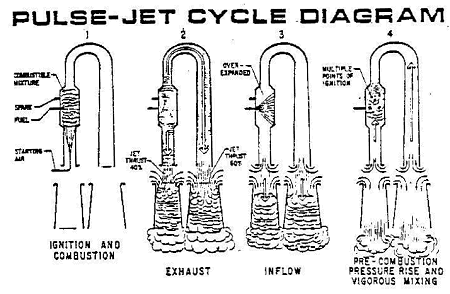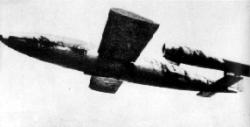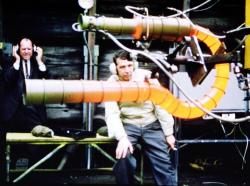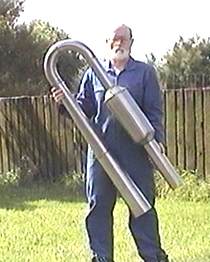Bringing the pulse jet engine into the 21st century
Last Updated: 13 February, 2002
|
Why Valveless? Given that a conventional pulse jet only has one moving part (the valve) one might be tempted to ask -- why bother to design and build a valveless pulse jet? Well the problem with conventional pulse jet engines is that the valves are subjected to intense physical and thermal punishment. As a result, they require regular replacement and represent a weak link in the engine's reliability.
So, by eliminating the valves, it should be possible to make an engine that is as simple as a ramjet having absolutely no moving parts.
The Lockwood-Hiller Design In 1967 they filed a patent for such an engine and produced a number of working prototypes for which some very impressive claims were made. The picture on the right is one of the Hiller-Lockwood prototypes being tested. This particular engine is said to have weighed in at just 30 pounds and produced around 300 pounds of thrust. Note that most of the engine is glowing with the heat produced. Also note that it appears as if the guy in the background thinks his hearing protection is inadequate.
One of the big claims to fame of this engine was that it was imune to the damaging effects of ingested foreign materials. Gas turbine engines by comparison are very easily destroyed by objects that get sucked into their intakes. In fact, every year many commercial airliners require major engine repairs after birds are sucked into the intakes.

The above diagram documents the basic theory of operation behind the valveless pulse jet and also shows the effect of the thrust augmentors that Hiller and Lockwood added to their engine. To explain in more detail what is happening:
Thrust Augmentors They work by recruiting extra (cool) fresh air by virtue of the venturi effect. This cool fresh air mixes with the hot exhaust gasses and, as a result, expands -- adding to the mass of air being propelled by the engine. There is some debate as to the effectiveness of these augmentors, with some clamiing up to a theoretical 50 percent thrust increase while others say that practical testing produced only a 10-15 percent gain.
Other Designs There are also a number of other designs around, although none have a reputation for ease of construction, power or simplicity of use. And here is a BIG valveless pulsejet used for warming orchards. The developer says he'll have the noise problem sorted out within a year and will be manufacturing these pulsejets for about $500 each. Mind you, the article is dated August 1999 -- I guess it's still too noisy.
I Built One I've documented the results (with video footage) on this page.
The engine is now mounted on my gokart and I intend to run some comprehensive performance (and road) tests sometime in the near future.
Unfortunately, starting a Lockwood-style engine is a little more risky than
starting a regular pulsejet engine. You can read all about my engine and
the accident I had when starting it on
my Lockwood Engine page.
|
|
 From what I've been able to discover, many of the pulse jet powered V1 "flying bombs"
which were launched by Germany against Britain during WW2 didn't actually reach their
targets because the engines failed enroute. Even extensive US government testing
undertaken by the NACA produced reed valves that were only good for about
20-30 minutes of continuous operation on larger engines.
From what I've been able to discover, many of the pulse jet powered V1 "flying bombs"
which were launched by Germany against Britain during WW2 didn't actually reach their
targets because the engines failed enroute. Even extensive US government testing
undertaken by the NACA produced reed valves that were only good for about
20-30 minutes of continuous operation on larger engines.
 Durnig the 1950s and 60s, some development work was done on the valveless
pulse jet concept in the USA by Hiller and Lockwood.
Durnig the 1950s and 60s, some development work was done on the valveless
pulse jet concept in the USA by Hiller and Lockwood.
 I Also Built A Lockwood/Hiller
I Also Built A Lockwood/Hiller